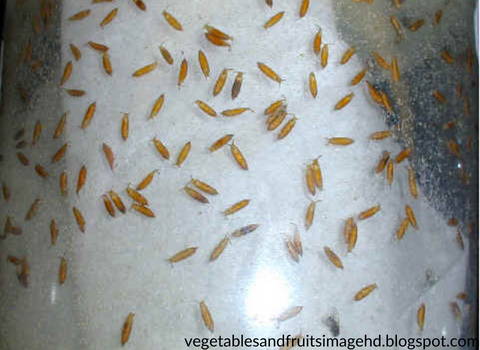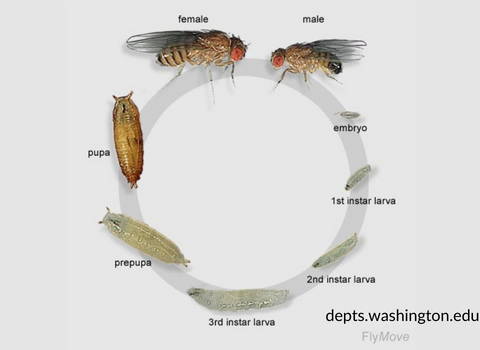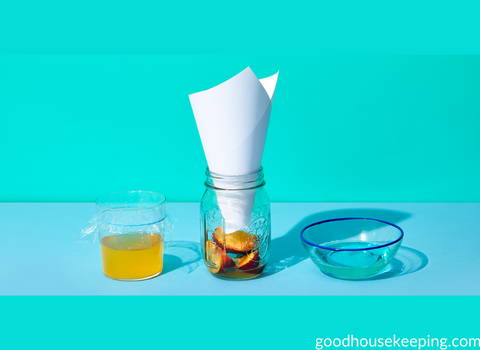Fruit Fly Eggs: What They Look Like and How to Eliminate Them
Fruit flies can invade your home anytime, but they are particularly common during fall or late summer because they are attracted to fermenting fruits and vegetables. Perishable items like tomatoes, grapes, melons, and squash are frequently the cause of a fruit fly infestation developing indoors.
These insects also love decaying fruit, onions, potatoes, and other unrefrigerated fruits and vegetables bought at the grocery store. This guide will tell you everything you need to know about fruit flies and their eggs and how you can prevent a fruit fly infestation from taking place in your home.
What Fruit Fly Eggs Look Like
Female fruit flies usually lay eggs in sugary, rotting organic material like decaying fruit or ripened fruit. They pick such breeding sites to provide a food source for their larvae and to get protection from predatory species. Fruit fly eggs thrive in temperatures ranging from 75⁰F to 80⁰F.
The yellow, rice grain-shaped eggs are only 1/2 mm long and can hatch within 30 hours in optimal temperatures. The larvae of fruit flies will eventually become an adult that will feed and lay another generation of fruit fly eggs.
Fruit Fly Life Cycle and Behavior
Fruit flies can be distinguished from fungus gnats through their colour. The latter is black or dark grey, while fruit flies can be black or tan. Fruit flies are usually found in homes, supermarkets, restaurants, and other places where there’s fermenting or rotting food.
Adult fruit flies are about 1/8” long and have red eyes. The rear portion of their body is black, while the front portion is tan. Fruit flies lay eggs near the surface of rotting or fermenting foods. Upon hatching, the fruit fly larvae will continue feeding near the surface of damp, organic materials, or fermenting fruit.
The larvae’s surface-feeding characteristic is so significant that over-ripened or damaged portions of vegetables and fruits should be removed so that you do not miss any developing larvae. Fruit flies have a huge reproductive potential as females can lay around 500 eggs. The life cycle of a fruit fly can be completed within a week, but how long do fruit flies live? These pests can live for up to 50 days under optimal conditions.
Fruit flies are particularly drawn to ripened and rotten fruit and veggies in the kitchen, but these insects will also lay eggs in cleaning rags, trash cans, vegetable matter, organic material, food waste, garbage disposals, drains, mops, and empty bottles. They only need a damp film of rotting or fermenting material to grow and thrive.
Fruit fly infestations can start from overripe fruits and veggies that were already infested and brought inside the house. Aside from this, adult fruit flies can enter your house through poorly screened doors and windows. Fruit flies are not just nuisance pests, but they may also contaminate food with disease-producing organisms.
How to Prevent Adult Fruit Flies from Infesting Your Home
The best way to prevent fruit fly infestations is to get rid of anything that attracts fruit flies. For example, overripe produce must be refrigerated, eaten, or thrown away. Damaged, cracked, or over-ripened portions of vegetables and ripened fruits with fruit fly eggs and larvae should be removed and discarded.
Recycling bins that have never been cleaned can also hold thousands of flies. So, to prevent fruit flies from entering your home and infesting your fruits and vegetables, you need to equip your doors and windows with tight-fitting screens.
Some products we recommend against fruit flies are:
How to Get Rid of Fruit Flies
The best way to control fruit fly populations is to make fly traps:
You only need a cardboard or a piece of paper and a jar to make your fly trap at home.
First, fill the jar with apple cider vinegar to attract the flies.
Next, roll a cardboard or a piece of paper into a funnel then place it in the jar.
The flies will not be able to escape the jar once they are caught inside.
Here is another way to make a fruit fly trap:
Place some bait like overripe produce inside a container then cover the top with plastic wrap.
Do not forget to secure the plastic wrap with a rubber band and poke holes so that flies can enter.
You can also make a DIY liquid soap trap:
Mix water, 1 to 2 tablespoons of apple cider vinegar, and a few drops of your preferred dish soap.
The soap will break the liquid’s surface tension, so the flies will drown in the solution.
Just remember that fruit fly traps will not be enough for fruit fly control as these tools can only capture the flying adult flies. The only way to get rid of the infestation completely is to find the fruit fly breeding areas first and then use an IGR or insect growth regulator to treat it.
This product can kill the immature larvae and eggs of fruit flies, including the drosophila melanogaster or common fruit fly. You can also use insecticide fogs to kill fruit flies and other small flies. These products can be sprayed behind and under equipment as well as in cracks, crevices, and hidden areas to get rid of fruit flies in their breeding areas.
Below are products we recommend to combat fruit flies in your home:




